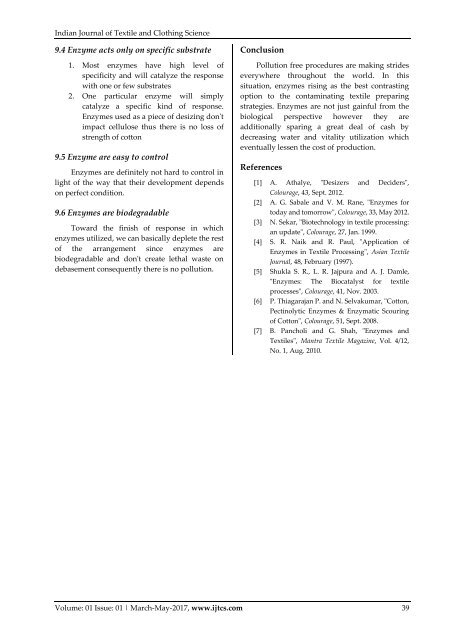IJTCS Vol.-1 Issue-1 March-May, 2017
The Indian Journal of Textile and Clothing Science (IJTCS) is a peer reviewed (refereed) national journal (India). Which is aimed at providing platform to exchange information pertaining to all sectors of textile and the clothing industry among researchers, textile technocrats, fashion designers and industrial experts. The journal focuses on scientific, technical, economical, managerial and all other aspects of textile activity at theoretical and experimental level. IJTCS is aimed at publishing original research articles, review papers, short communications, and letters to the editor and book reviews catering the needs of both industry and academia.
The Indian Journal of Textile and Clothing Science (IJTCS) is a peer reviewed (refereed) national journal (India). Which is aimed at providing platform to exchange information pertaining to all sectors of textile and the clothing industry among researchers, textile technocrats, fashion designers and industrial experts.
The journal focuses on scientific, technical, economical, managerial and all other aspects of textile activity at theoretical and experimental level. IJTCS is aimed at publishing original research articles, review papers, short communications, and letters to the editor and book reviews catering the needs of both industry and academia.
Create successful ePaper yourself
Turn your PDF publications into a flip-book with our unique Google optimized e-Paper software.
Indian Journal of Textile and Clothing Science<br />
9.4 Enzyme acts only on specific substrate<br />
1. Most enzymes have high level of<br />
specificity and will catalyze the response<br />
with one or few substrates<br />
2. One particular enzyme will simply<br />
catalyze a specific kind of response.<br />
Enzymes used as a piece of desizing don't<br />
impact cellulose thus there is no loss of<br />
strength of cotton<br />
9.5 Enzyme are easy to control<br />
Enzymes are definitely not hard to control in<br />
light of the way that their development depends<br />
on perfect condition.<br />
9.6 Enzymes are biodegradable<br />
Toward the finish of response in which<br />
enzymes utilized, we can basically deplete the rest<br />
of the arrangement since enzymes are<br />
biodegradable and don't create lethal waste on<br />
debasement consequently there is no pollution.<br />
Conclusion<br />
Pollution free procedures are making strides<br />
everywhere throughout the world. In this<br />
situation, enzymes rising as the best contrasting<br />
option to the contaminating textile preparing<br />
strategies. Enzymes are not just gainful from the<br />
biological perspective however they are<br />
additionally sparing a great deal of cash by<br />
decreasing water and vitality utilization which<br />
eventually lessen the cost of production.<br />
References<br />
[1] A. Athalye, "Desizers and Deciders",<br />
Colourage, 43, Sept. 2012.<br />
[2] A. G. Sabale and V. M. Rane, "Enzymes for<br />
today and tomorrow", Colourage, 33, <strong>May</strong> 2012.<br />
[3] N. Sekar, "Biotechnology in textile processing:<br />
an update", Colourage, 27, Jan. 1999.<br />
[4] S. R. Naik and R. Paul, "Application of<br />
Enzymes in Textile Processing", Asian Textile<br />
Journal, 48, February (1997).<br />
[5] Shukla S. R., L. R. Jajpura and A. J. Damle,<br />
"Enzymes: The Biocatalyst for textile<br />
processes", Colourage, 41, Nov. 2003.<br />
[6] P. Thiagarajan P. and N. Selvakumar, "Cotton,<br />
Pectinolytic Enzymes & Enzymatic Scouring<br />
of Cotton", Colourage, 51, Sept. 2008.<br />
[7] B. Pancholi and G. Shah, "Enzymes and<br />
Textiles", Mantra Textile Magazine, <strong>Vol</strong>. 4/12,<br />
No. 1, Aug. 2010.<br />
<strong>Vol</strong>ume: 01 <strong>Issue</strong>: 01 | <strong>March</strong>-<strong>May</strong>-<strong>2017</strong>, www.ijtcs.com 39



